Indian pace attack best in history of cricket, claims Mohammad Shami
Mohammad Shami, who is an integral part of India’s pace attack that has run riot in Test cricket since 2018, has claimed that the quartet, which includes himself, Umesh, Ishant and Bumrah, is the best in the sport’s history. Shami also further spoke about his secret of succeeding in the 2nd innings.

For decades, the Indian cricket team was seen as a spin-heavy side which rarely boasted any world-class fast bowler, and the same reflected in the side’s results, with the team seldom winning away from home. While talented pacers did emerge every now and then, failure to realize potential meant that those players faded away in no time, in turn, bringing the team back to square one.
However, post the debut of Jasprit Bumrah in late 2017, the tables turned drastically and ever since, India, thanks to the pace quartet of Bumrah, Shami, Ishant and Umesh Yadav, have been seen as the team with the best pace attack in the world. Such was the attack’s dominance that in 2019, the quartet took a remarkable 95 Test wickets at an average of 15.16.
However, while they are considered to be the best pace attack in the world currently, Mohammad Shami has gone one step further and has branded them the best in the game’s history.
"You and everyone else in the world will agree to this - that no team has ever had five fast bowlers together as a package," Shami told the former India wicketkeeper Deep Dasgupta on Cricketbaazi, a Hindi talk show on ESPNcricinfo.
"Not just now; in the history of cricket, this might be the best fast-bowling unit in the world."
A striking aspect in the bowling of all the aforementioned pacers is their tendency to adapt quickly, with them, as a unit, often seen taking wickets at regular intervals - something that has helped the team to an immeasurable extent. According to Shami, he and his teammates tend to bowl a tight line and length when they are trying to dismiss a set batsman, while they ramp up the pace once a new batsman arrives.
"If the batsman is set and we haven't been able to pick up a lot of wickets, we try to bowl a tight line and length by dropping our pace.
"As soon as we get a wicket, you increase your pace by about 8kph. This difference in speed is pretty visible. If the bowler was bowling at around 140kph earlier, after picking up a wicket he gets his rhythm back, picks up the pace and the same ball is now delivered at 145kph.”
This aforementioned aspect, according to the 29-year-old, is the sole reason for him succeeding in the second innings. The Bengal pacer averages a remarkable 21.98 in the second innings of Test matches, as compared to 32.50 in the first innings.
"My mindset while bowling is that if the batsman is playing well, bowl a tight line and length, dry up the runs, and he will surely make a mistake. Once the set batsman is dismissed, I go for the kill as a bowler. That's why it seems like I bowl in two different ways. The 'second-innings Shami' label - that has been created by you guys (the media)."

Comments
Sign up or log in to your account to leave comments and reactions
0 Comments